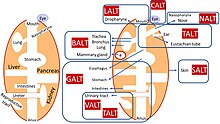Mucosa-associated lymphoid tissue
| Mucosa-associated lymphoid tissue | |
|---|---|
| Details | |
| System | Lymphatic system |
| Identifiers | |
| Acronym(s) | MALT 2 |
| FMA | 62819 |
| Anatomical terminology | |
The mucosa-associated lymphoid tissue (MALT), also called mucosa-associated lymphatic tissue, is a diffuse system of small concentrations of lymphoid tissue found in various submucosal membrane sites of the body, such as the gastrointestinal tract, nasopharynx, thyroid, breast, lung, salivary glands, eye, and skin. MALT is populated by lymphocytes such as T cells and B cells, as well as plasma cells, dendritic cells and macrophages, each of which is well situated to encounter antigens passing through the mucosal epithelium. The appendix, long misunderstood as a vestigial organ, is now recognized as a key MALT structure, playing an essential role in B-lymphocyte-mediated immune responses, hosting extrathymically derived T-lymphocytes, regulating pathogens through its lymphatic vessels, and potentially producing early defenses against diseases. In the case of intestinal MALT, M cells are also present, which sample antigen from the lumen and deliver it to the lymphoid tissue. MALT constitute about 50% of the lymphoid tissue in human body. Immune responses that occur at mucous membranes are studied by mucosal immunology.
Categorization
[edit]
The components of MALT are sometimes subdivided into the following:
- GALT (gut-associated lymphoid tissue. Peyer's patches are a component of GALT found in the lining of the small intestines.)
- BALT (bronchus-associated lymphoid tissue)
- NALT (nasal-associated lymphoid tissue)
- CALT (conjunctival-associated lymphoid tissue)[1]
- LALT (larynx-associated lymphoid tissue)
- SALT (skin-associated lymphoid tissue)
- VALT (vulvo-vaginal-associated lymphoid tissue)
- TALT (testis-associated lymphoid tissue)
It can be also distinguished by level of organization of the tissue:
- O-MALT (organized mucosa-associated lymphatic tissue); specifically, the tonsils of Waldeyer's tonsillar ring are O-MALT.[2]
- D-MALT (diffuse mucosa-associated lymphatic tissue); MALT that is not organized as a separately macroscopically anatomically identifiable mass, tissue or organ (such as the aforementioned O-MALT) is diffuse MALT.[2]
Role in disease
[edit]MALT plays a role in regulating mucosal immunity. It may be the site of lymphomas, usually a non-Hodgkin lymphoma. A specific entity is the marginal zone B-cell lymphoma (a subtype of which is termed MALT lymphoma). Certain subtypes of marginal zone B cell lymphomas such as those occurring in the stomach are commonly caused by Helicobacter pylori infection.[3] Peyer's Patches, groupings of lymphoid follicles in the mucous membrane, monitor the GALT closely to regulate pathogens that traverse through the area. Due to the function of M cells in Peyer's patches, involving the adherence and transport of antigens across a single layer of epithelial cells, dysfunction in these structures could allow an entry point to pathogens.
References
[edit]- ^ Hong Liang; Christophe Baudouin; Antoine Labbe; Luisa Riancho; Françoise Brignole-Baudouin (2012). "Conjunctiva-associated lymphoid tissue (CALT) reactions to antiglaucoma prostaglandins with or without BAK-preservative in rabbit acute toxicity study". PLoS One. 7 (3): e33913. doi:10.1371/journal.pone.0033913. PMC 3307783. PMID 22442734.
- ^ a b Gray's Anatomy, 38ed. p. 1442 ff.
- ^ Violeta Filip P, Cuciureanu D, Sorina Diaconu L, Maria Vladareanu A, Silvia Pop C (2018). "MALT lymphoma: epidemiology, clinical diagnosis and treatment". Journal of Medicine and Life. 11 (3): 187–193. doi:10.25122/jml-2018-0035. PMC 6197515. PMID 30364585.
External links
[edit]- MALT resource page - Patients Against Lymphoma
- Maltoma
- [1]
- [2]
- ^ Kooij IA, Sahami S, Meijer SL, Buskens CJ, Te Velde AA. The immunology of the vermiform appendix: a review of the literature. Clin Exp Immunol. 2016 Oct;186(1):1-9. doi: 10.1111/cei.12821. Epub 2016 Jul 19. PMID: 27271818; PMCID: PMC5011360.
